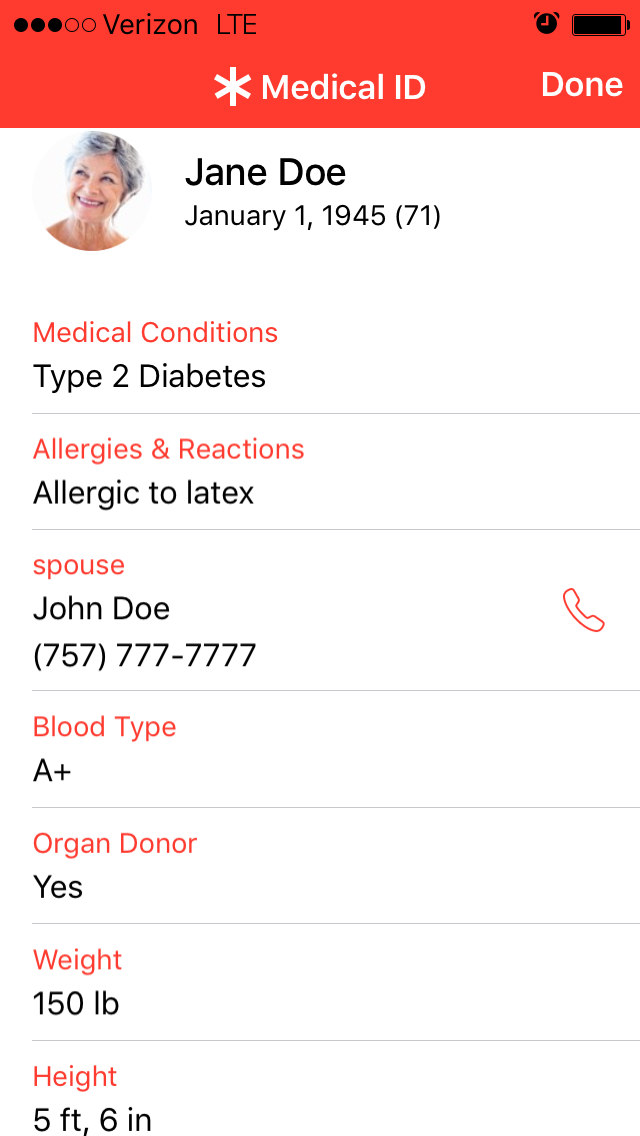Life-Saving Tech Tip for Cell Phone Users
Your cell phone may have a life-saving feature that you should be aware of. For iPhone users, the feature is called “Medical ID.” Medical ID lets others access important medical information about you without unlocking your phone. From the “unlock” screen, a first responder can tap the “Emergency” option in the bottom left corner, then “Medical ID,” and view your name, date of birth, a photo of you, emergency contacts, blood type, height, weight, allergies, medications, and medical conditions – or any other information you wish to include.

To set up your Medical ID, locate and open the “Health” app that is installed by default onto your iPhone, then press “Create Medical ID.” Enter the information that you would like displayed in the event of an emergency, and be sure to turn on “Show When Locked,” then click “Done.”
For other types of cell phones, a similar feature may be available either as a phone setting or in the form of an “ICE: In Case of Emergency” app. Check for an emergency contact feature in your phone’s settings or consider editing your lock screen or wallpaper to include important information.
In addition to including personal information, you may want to use these cell phone features to indicate that your advance medical directive is a part of the U.S. Living Will Registry, so that medical professionals can access that document if needed.
Don’t have an advance medical directive, or want to participate in the U.S. Living Will Registry? Give the Hook Law Center a call today.
Ask Kit Kat – Falling Cats
Hook Law Center: Kit Kat, what can you tell us about the phenomenon of cats always landing on their feet?
Kit Kat: Well, the answer is not as simple as it may appear, but it is extremely interesting. Actually, it’s not a definitive answer, because scientists are not really sure how it occurs or if it occurs in only one way. They do agree, however, that cats will right themselves after falling from most distances, even from as little as a height of 2 feet. The only exception is a height of less than 2 feet. From distances less than 2 feet, there is not enough room or time to perform their acrobatics.
Here’s what we know now. Falling cats have been a fascination of the scientific community since the 19th century. George Gabriel Stokes and James Clerk Maxwell were 19th century scientists who were intrigued by the falling cat phenomenon. They experimented and dropped many cats; in all cases, they righted themselves. Yet, later scientists were not satisfied. How could cats accomplish this feat which defied the law of conservation of angular momentum? That law involves the person or object to push off from something, but cats were not pushing off from anything, and they were still able to right themselves. Now enters Etienne Jules Marey, a French scientist and engineer, who used high-speed photography in 1894 to capture 32 shots of cats in midair. His photos revealed what was happening – “…the cat first tucked in its forelegs while stretching out its back legs, then switched them, which allow it to use the inertia of its own mass to flip.” Marey called this ‘the tuck and turn’ method. It is what modern gymnasts do when they accomplish their amazing flips and turns.
20th century scientists have since quantified the process. In 1935, Dutch physiologists GGJ Rademaker and JWG Ter Braak created a mathematical drawing of a falling feline which further refined the theory. By bending at the waist, their drawing showed the cat’s body as 2 can-like cylinders rotating on 2 axes in different directions. The net energy expended created an equilibrium of 0. A 21st century scientist, Greg Gbur of UNC-Charlotte calls this the ‘bend and twist’ method. The research continues. Scientists would like to find one definitive answer, but the crafty feline is not bound to comply. Gbur laments, ‘Probably the cat uses multiple different strategies to turn over. Physics prefers and tends to look for the simplest explanation for a phenomenon, whereas evolution—if I anthropomorphize it—is always looking for the most efficient. Living creatures are doing whatever works best, which may not be the simplest option.’
(Karen Bruillard, “Scientists just can’t stop studying falling cats,” The Washington Post, Animalia section, November 4, 2016)
Distribution of This Newsletter
Hook Law Center encourages you to share this newsletter with anyone who is interested in issues pertaining to the elderly, the disabled and their advocates. The information in this newsletter may be copied and distributed, without charge and without permission, but with appropriate citation to Hook Law Center, P.C. If you are interested in a free subscription to the Hook Law Center News, then please telephone us at 757-399-7506, e-mail us at mail@api.hooklaw.net or fax us at 757-397-1267.
